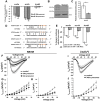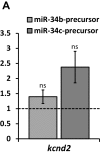KChIP2 is a core transcriptional regulator of cardiac excitability
- PMID: 28263709
- PMCID: PMC5338919
- DOI: 10.7554/eLife.17304
KChIP2 is a core transcriptional regulator of cardiac excitability
Abstract
Arrhythmogenesis from aberrant electrical remodeling is a primary cause of death among patients with heart disease. Amongst a multitude of remodeling events, reduced expression of the ion channel subunit KChIP2 is consistently observed in numerous cardiac pathologies. However, it remains unknown if KChIP2 loss is merely a symptom or involved in disease development. Using rat and human derived cardiomyocytes, we identify a previously unobserved transcriptional capacity for cardiac KChIP2 critical in maintaining electrical stability. Through interaction with genetic elements, KChIP2 transcriptionally repressed the miRNAs miR-34b and miR-34c, which subsequently targeted key depolarizing (INa) and repolarizing (Ito) currents altered in cardiac disease. Genetically maintaining KChIP2 expression or inhibiting miR-34 under pathologic conditions restored channel function and moreover, prevented the incidence of reentrant arrhythmias. This identifies the KChIP2/miR-34 axis as a central regulator in developing electrical dysfunction and reveals miR-34 as a therapeutic target for treating arrhythmogenesis in heart disease.
Keywords: INa; Ito; KChIP2; Kv4.3; Nav1.5; cell biology; heart failure (HF); human; human biology; medicine; rat.
Conflict of interest statement
The authors declare that no competing interests exist.
Figures









Similar articles
-
Myocardial KChIP2 Expression in Guinea Pig Resolves an Expanded Electrophysiologic Role.PLoS One. 2016 Jan 14;11(1):e0146561. doi: 10.1371/journal.pone.0146561. eCollection 2016. PLoS One. 2016. PMID: 26764482 Free PMC article.
-
MG53, A Novel Regulator of KChIP2 and Ito,f, Plays a Critical Role in Electrophysiological Remodeling in Cardiac Hypertrophy.Circulation. 2019 Apr 30;139(18):2142-2156. doi: 10.1161/CIRCULATIONAHA.118.029413. Circulation. 2019. PMID: 30760025
-
Preservation of cardiac function by prolonged action potentials in mice deficient of KChIP2.Am J Physiol Heart Circ Physiol. 2015 Aug 1;309(3):H481-9. doi: 10.1152/ajpheart.00166.2015. Epub 2015 Jun 8. Am J Physiol Heart Circ Physiol. 2015. PMID: 26055791
-
Kv4.3-Encoded Fast Transient Outward Current Is Presented in Kv4.2 Knockout Mouse Cardiomyocytes.PLoS One. 2015 Jul 21;10(7):e0133274. doi: 10.1371/journal.pone.0133274. eCollection 2015. PLoS One. 2015. PMID: 26196737 Free PMC article.
-
KChIP2 attenuates cardiac hypertrophy through regulation of Ito and intracellular calcium signaling.J Mol Cell Cardiol. 2010 Jun;48(6):1169-79. doi: 10.1016/j.yjmcc.2009.12.019. Epub 2010 Jan 4. J Mol Cell Cardiol. 2010. PMID: 20051248 Free PMC article.
Cited by
-
Transcriptional and Epigenetic Regulation of Cardiac Electrophysiology.Pediatr Cardiol. 2019 Oct;40(7):1325-1330. doi: 10.1007/s00246-019-02160-w. Epub 2019 Jul 25. Pediatr Cardiol. 2019. PMID: 31346662 Free PMC article. Review.
-
Ventricular arrhythmogenic remodelling in diet-induced metabolic syndrome driven by right-to-left regional differences in action potential duration and dominant frequency gradients.J Physiol. 2025 May;603(10):2979-3000. doi: 10.1113/JP286516. Epub 2025 May 5. J Physiol. 2025. PMID: 40320918 Free PMC article.
-
KChIP2 regulates the cardiac Ca2+ transient and myocyte contractility by targeting ryanodine receptor activity.PLoS One. 2017 Apr 6;12(4):e0175221. doi: 10.1371/journal.pone.0175221. eCollection 2017. PLoS One. 2017. PMID: 28384221 Free PMC article.
-
A common variant alters SCN5A-miR-24 interaction and associates with heart failure mortality.J Clin Invest. 2018 Mar 1;128(3):1154-1163. doi: 10.1172/JCI95710. Epub 2018 Feb 19. J Clin Invest. 2018. PMID: 29457789 Free PMC article.
-
Pulsatile MEK Inhibition Improves Anti-tumor Immunity and T Cell Function in Murine Kras Mutant Lung Cancer.Cell Rep. 2019 Apr 16;27(3):806-819.e5. doi: 10.1016/j.celrep.2019.03.066. Cell Rep. 2019. PMID: 30995478 Free PMC article.
References
-
- Bernardo BC, Gao XM, Winbanks CE, Boey EJ, Tham YK, Kiriazis H, Gregorevic P, Obad S, Kauppinen S, Du XJ, Lin RC, McMullen JR. Therapeutic inhibition of the miR-34 family attenuates pathological cardiac remodeling and improves heart function. PNAS. 2012;109:17615–17620. doi: 10.1073/pnas.1206432109. - DOI - PMC - PubMed
Publication types
MeSH terms
Substances
Grants and funding
LinkOut - more resources
Full Text Sources
Other Literature Sources
Molecular Biology Databases
Research Materials
Miscellaneous

